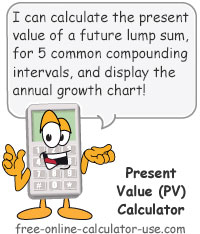IMPORTANT: Numeric entry fields must not contain dollar signs, percent signs, commas, spaces, etc. (only digits 0-9 and decimal points are allowed).
Click the Terms tab above for a more detailed description of each entry.
Step #1:
Enter the future lump sum you would like to calculate present value for.
Step #2:
Select either "Months" or "Years" and enter the corresponding number of periods to calculate present value for.
Step #3:
Enter the present value discount rate.
Step #4:
Select the applicable discounting interval.
Step #5:
Click the "Calculate Present Value" button. This will display the calculated present value of the lump sum, the interest earnings, and a year-by-year growth chart.





Follow me on any of the social media sites below and be among the first to get a sneak peek at the newest and coolest calculators that are being added or updated each month.